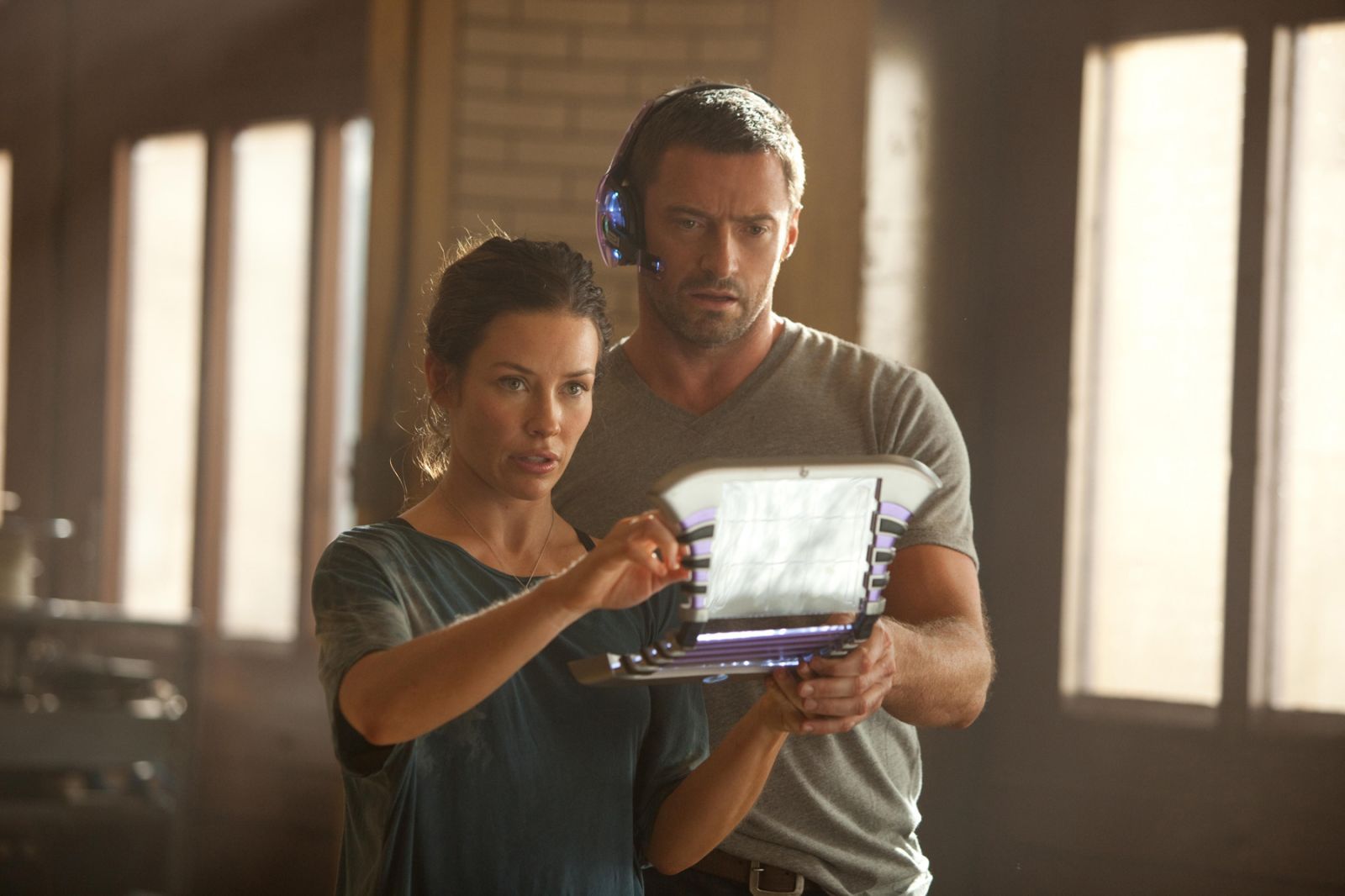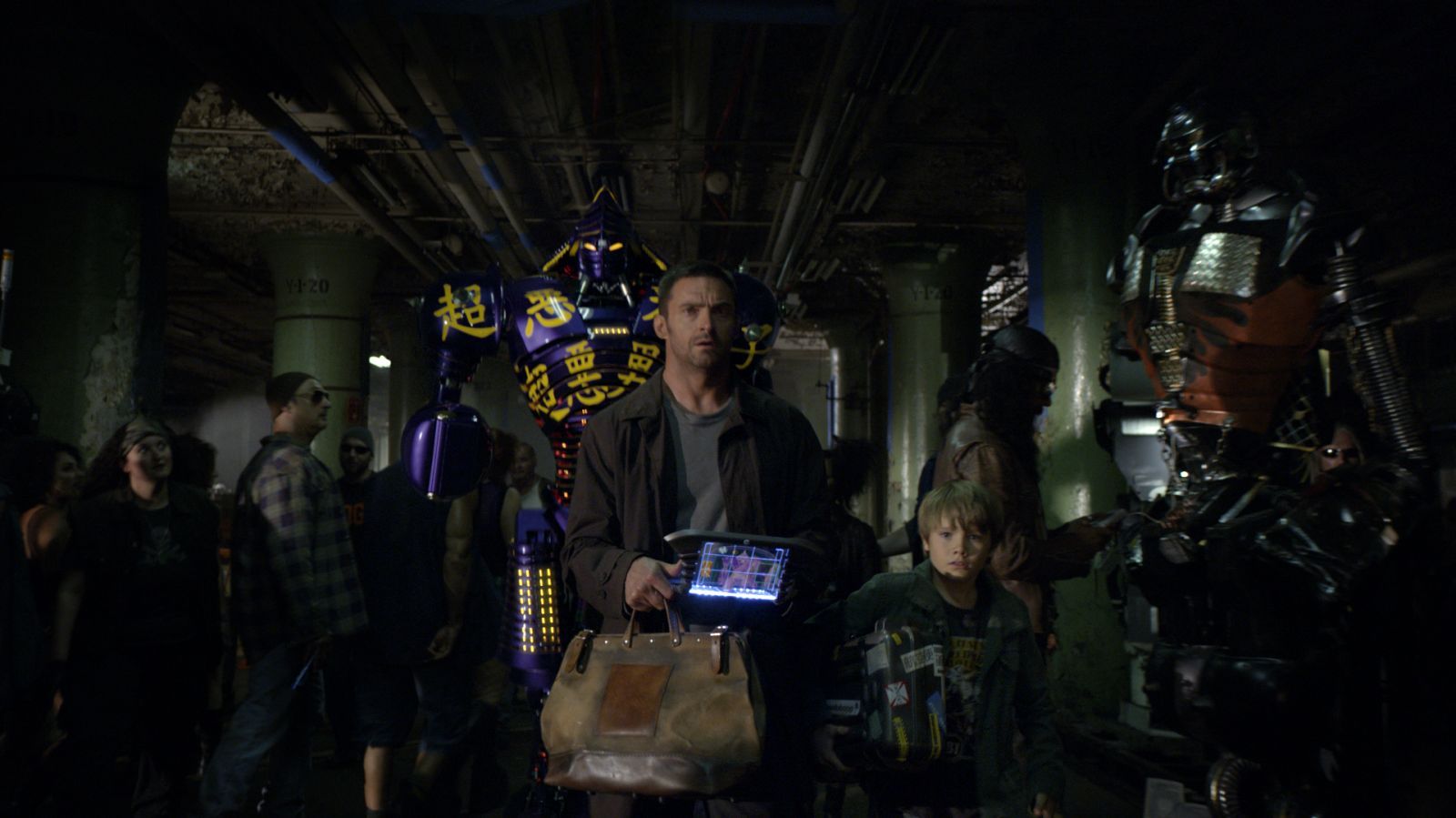DreamWorks' Real Steel is loosely based on the short story "Steel" by Richard Matheson, which was previously adapted by the author into a 1963 episode of The Twilight Zone. Last September, Spinoff Online was invited to the film’s Detroit set, where we met director Shawn Levy and star Hugh Jackman, who discussed how their vision of the near-future world off robot boxing differs from the source material.
"In Matheson's short story, boxing's been banned because there's been a series of people being killed," Jackman explained. "What Shawn, I think, smartly did is not base it on tha,t but more that it’s just evolved. There's still boxing. There's actually no money in it."
Levy elaborated on that evolution from human boxing to the mech mayhem seen in the movie.
"The world is 2020. The world is recognizably linked to the one we're sitting in right now, but this one sport has evolved," Levy said. "With the rise of UFC, mixed martial arts, the decline of conventional boxing, the thirst for spectacle, for carnage, we're already seeing the effect of it."
He also noted how the real world is subtlety embracing robots as substitutes for humans. When Levy’s Night at the Museum 2 was coming out, so too was Michael Bay's Transformers: Revenge of the Fallen. "The entire ad campaign ... they literally were skipping the humans. I said, 'I can't believe it. They literally don't give a shit about people any more,' and clearly it worked. Neither did the audience," Levy mused.
The world of Real Steel has taken that notion to the next level. "Where this movie goes ... it's people's desire for spectacle, unhindered by the frailty of the human body, has given rise to this sport,” Levy explained. “We're building machines so we can pay our money and watch them completely wail on each other."
In a nod to Matheson's 1956 short story, and The Twilight Zone episode, the earliest bots in the league are vaguely human-looking. Over the years, the robot designs become bigger, more powerful. "The desire for an anthropomorphized fighter waned,” Levy said. “The desire for a demolition derby with operatic scale violence grew."
Jackman's character Charlie Kenton was a boxer struggling to make his name during the sport's decline. He retires with a shabby record of 24 and 19. "But as Evangeline Lilly says in the movie, '24 and 19, but every fight a knockout,'" Levy said. "With this guy a fight wasn't over until someone was on the mat. [Charlie] has no illusions about what he is, but he's a scrapper and he's gonna keep swinging until he can't swing no more."
And while Charlie and the sport of boxing were going down, tech geniuses like Tak Mashido (played by Karl Yune) were on the rise in the new pugilistic order of the World Robot Boxing (WRB) league.
"Tak Mashido is the god of this WRB,” Levy said. “When he was 22, he was like this wunderkind out of Japan who designed an early league robot named Noisy Boy. [After a few years] he's a millionaire artist-designer. He both designed the aesthetics of the robot and the program. Crazy, crazy genius."
And if you're not a crazy, crazy genius, you can still get into the robot fight game.
"There are two tiers in the movie: underworld and league,” Levy said. “WRB ... is the bigs. It is NASCAR, NBA, global, corporate-sponsored, big money. But that ain't the world [Charlie] lives in. He lives in the underworld, which is county fairs, old, abandoned car factories, the post-industrial detritus of the American landscape. No rules. Fight until one robot is done moving."
And Charlie is far from a genius.
"He's limited. He does what he has to do. There's no passion for him involved. He knows what he needs to know in terms of being able to buy a good robot -- how much it's worth, how to operate it," Jackman elaborated. "But the brains in terms of robotics is [Lilly's character] Bailey, who is sort of his partner. She's someone who genuinely understands and knows this stuff."
Charlie and Bailey are barely scraping by in the underworld of boxing, and it takes all of the fighter's resourcefulness to keep the wolves from his door. Levy points out that the feeling of desperation in the leading man comes directly from Matheson's story.
"Charlie is desperate,” Jackman said. “He is down and out. He's also quite a charming character in his way and he's got a little bit of the huckster to him. He's got debts here and there, this person, that person, and he's conning this guy and conning that."
Needless to say, when two strangers show up on his door, he assumes the worst. "What I presume are guys coming to get money that I owe from them,” the actor said, “and I actually get in a fight with one of the guys, turns out to be these guys appointed by the courts. [They're] coming to tell me that ... I have to turn up in court to deal with custody."
Custody, that is, of a 10-year-old son he abandoned at birth. Max, played by newcomer Dakota Goyo, has no place in Charlie's shady existence. But as you might expect, they begin to find a new start.
"They're kind of forced together,” Jackman said. “Neither of them really want to be with each other. They're two damaged souls and, together, by luck really they find this junk-yard robot, literally in the garbage.”
That robot is Atom, the lead mech in Real Steel. Although he's made of steel, he's the heart of the humanistic tale that Levy set out to tell.
"The boy, the father and the machine are cast-offs. They're forgotten,” the director said. “They're either on the margins of society or they're literally – this robot they find buried in the earth of a junkyard. So you have this trinity of forgotten beings, who having met each other, come back to life."
And while Atom is a character in the movie, Levy cautioned that these robots aren’t intelligent, artificially or otherwise.
"Robots don't have personality,” he said. They all have very specific individuated aesthetics. They don't talk, they don't express feelings. They are controlled by humans. They do not walk around in the street. It's not A.I. They are not servants or butlers. It's not a mechanized society."
Still, Max, and most likely the audience, will sense something more to Atom as he helps Charlie to build his comeback around the robot.
"Where the movie, I think, hopefully gets some of its magic ... it's that this robot Atom, who is a piece of shit, who is obsolete compared to most of the other robots in the league, [yet] there's something about this robot that the kid believes," Levy said. "It's like, 'Are you in there? Is there something in there?' The robot doesn't talk, doesn't move, doesn't express anything, but when you meet him, when you see his face, you understand it. There's something in this bot, in the design of this bot, that hints at maybe something resembling a soul."
But Atom will face some formidable opponents in the ring. Levy told us they designed some 20 robots for the fight scenes in Real Steel. The reigning champ of the WRB is Zeus, who was groomed for the belt by Farrah Lenkova (played by Olga Fonda).
"She's the daughter of a Russian oligarch dynasty. Dad's a billionaire. They wanted to build the first super-bot, the bot that couldn't be defeated. So the Lenkovas went to Tak Mashido," Levy explained. "The Lenkovas brought Tak Mashido out of retirement – open checkbook, bottomless pockets, ‘Build us and design us a bot that can't lose.’ And he designs Zeus."
Sitting in Detroit's Cobo Arena, Levy and Jackman talked in between takes on the massive WRB ring that inhabits the exhibition center's floor. As they laid out the storyline for the film, we couldn’t help but recognize that the scenes we were witnessing are part of that climactic confrontation between the leagues alpha and omega, Atom and Zeus.
To describe what we saw would certainly be a spoiler, although Jackman might insist it's not the boxing matches that are important to them movie.
"It's a bit like Rocky,” he said. “It's a lot less boxing then you all might imagine. It's not wall-to-wall robot boxing. Really, it's relationships.”
Shawn Levy's tale of loss and redemption through robot boxing opens in theaters Oct. 7.
Related: High Tech Meets Classic Film on the Set of Real Steel




